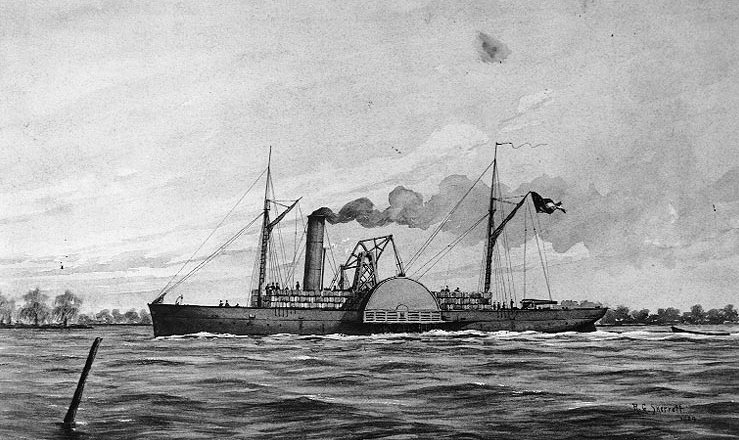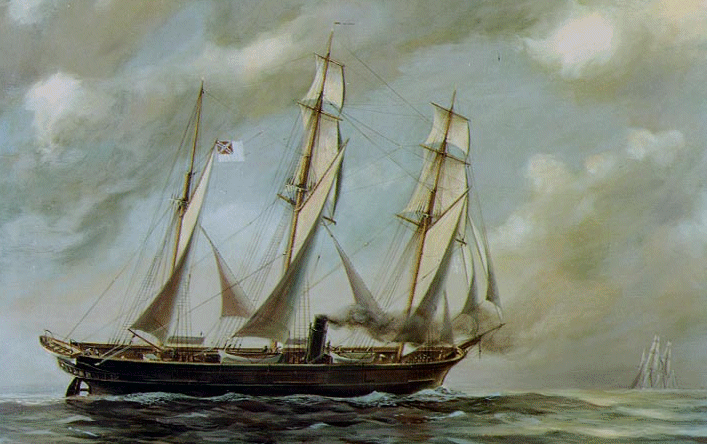|
Naval
Warfare in the American Civil War
the
second in a three part series
by
Peter Hunt
As I mentioned in part one of this
article, naval aspects of the American Civil War covered three distinct
areas of operations: riverine, coastal and high seas.
Whilst riverine warfare was basically an adjunct of the land
campaigns, the sea war was determined by economics.
The coastal warfare was caused by the Union attempts to blockade the
coast of the Confederacy and the Confederate attempts to break their
blockade. On the high seas the
boot was on the other foot, as Confederate raiders attempted to destroy
Union merchant ships, whilst the USN attempted to protect them.
In simple terms it could be said that the Union won the war of the
blockade and that the Confederates won the war of commerce.
The Blockade
As soon as a war began the North declared
a blockade of the sudden coastline harbours.
This had the effect of legally prohibiting those waters to neutral
shipping. However to qualify
for this under accepted international law the blockade had to be effective,
in this respect the Union declaration was very much a bluff as at the
beginning of the war the USN only consisted of about 50 ships, many of which
were obsolete, and many of the newer ships were on far-flung overseas
stations from Japan to the Mediterranean.
To enforce a blockade the Union brought its industrial capacity to
bear and commenced a massive shipbuilding programme that was supported by
the conversion of suitable merchant ships to warships.
Although ships were built in record time (one class was known as the
"90 day gunboats" referring to the duration of their
construction), blockade took time to become effective, however, the
Confederate's never took advantage of this to declare it broken and open the
ports to neutral shipping with war supplies that they so desperately needed.
In my opinion by not breaking the
blockade, the South lost the war, as without foreign assistance they could
not hope to match economic strength of the North and, short of some knockout
blow against Washington leading to a political collapse, they would be
certain to lose a war of attrition. Which,
in the end, they did. Basically
the South could have broken the blockade in two ways, either by securing a
port or ports with its own warships and preventing the USN from interfering,
or by running so many merchant ships through the blockade that it was shown
to be ineffective. Since there
was no Confederate navy at the beginning of the war the first option with a
non-starter but were plenty of merchant ships available with cargoes that
were wanted in Europe - cotton.
With no synthetic fibres, cotton was much
more important that is today and, although not quite a strategic commodity,
the lack of which would bring the economies of Europe to grinding halt, the
Confederate's reasoned that by withholding its cotton from Europe, with the
excuse of the blockade, so much inconvenience would be caused that one or
more of the European powers would intervene militarily to open the Southern
ports and thus side with the Confederacy.
Consequently no centrally organised attempted to run the blockade en
masse was made and what blockade running there was left a free enterprise,
with the added disadvantage that returning ships were loaded with the items
that would show the highest profits when resold in the Confederacy, such as
stays for women's corsets, rather than armaments and war material.

USS
Saugus, published by WRM Graphics, Inc. (www.wrmgraphics.com)
Image
copyright 1993 by William R. McGrath
The Confederate gamble, for such it was,
on cotton commerce almost came off. Depressions
in the textile industries of Britain, France and Russia came within an ace
of inducing those governments to intervene in the ACW.
In the final analysis this was prevented by the exploitation of new
sources of cotton, notably Egypt, and Lincoln seizing the moral high ground
by the emancipation of the slaves which, especially with regards the British
public, put the Southern cause beyond the pale.
Perhaps just as significantly it turned out that Northern grain was
just as important to the economies of Europe are Southern cotton was.
The South never had the naval capacity to
break the blockade although the came close to it once.
In early 1863 to small Confederate ironclads, Chicora and Palmetto
State sortied out of Charleston harbour.
The blockading squadron had no armoured ships and was completely
outclassed. One Yankee ship was
sunk two struck the colours. It
appeared that the blockade had been broken, if only for a very short time.
This in itself a significant because before the blockade could be
reinstated the North was legally obliged to inform all the foreign
governments concerned and that would take weeks.
However since the Southern ironclads were unable to put prize crews
on the surrendered Northern ships, they both unsurrendered themselves,
raised their colours again and sailed off in the confusion. The Federal government just bluntly refused to acknowledge
that the blockade had been broken and reinforced Charleston with ironclads
that would put a stop to any further sorties by Chicora and her consort.
Whilst all is fair in love and war, you can understand why most
Southerners felt that Northern officers were not quite gentleman.
As the war progressed the blockading got
tighter and tighter. More Union
ships were available and more Southern ports were closed by Union attacks.
Although never completely watertight, a blockade of the South
eventually proved effective. In the final analysis the Confederacy was choked to death.
The Raiders
In the American War of Independence and
the War of 1812 the Americans had successfully used raiders to attack
British merchant shipping, causing considerable merchant losses and forcing
the British to dissipate their naval effort by escorting merchantmen and
hunting down raiders. Since at
the beginning of the ACW the Union merchant marine was second only in size
to the British it was an obvious target for the South's economic warfare.
Traditionally there were two methods of
waging naval war against an enemy's trade.
You could detach your own naval vessels to track down and destroy the
enemy's merchantman or you could employ free enterprise by issuing
"letters of marque" to anyone who would fit out a ship to attack
the enemy's trade on the understanding that he kept the profit therefrom. Although the South did authorise some privateers of the
latter kind in the ACW the profits to be made from blockade running offered
an easy and better return on raiding. Consequently
practically all the significant Southern raiders were units of the
Confederate navy under regular officers, although the crews were often much
more diverse in origin. The
ships themselves were equally diverse.
Most were converted merchantman, lightly built and lightly armed, the
first Confederate raider Nashville carried only two 12 ponder cannon, but
since their targets had no guns at all that was enough.
A few raiders were purpose-built in Britain and France.
Fast, strongly built ships, they had their guns added when they were
outside territorial waters. In many respects raiders of this type, such as the Alabama
and Florida, both British built, were equal to Union warships of comparable
size.
Ironically enough the Union navy had been
designed to fight a commerce war, but the other way around.
The backbone of the Northern fleet was a class of fast, heavily
armoured steam frigates, designed to attack any merchant shipping and
outfight any warships that they couldn't outrun.
Although they were fine ships they were never enough for them to
track down the Confederate raiders and, since the Confederate ships were by
no means powerful men-of-war the job of hunting them could be left to less
powerful sloops. Even so there
were never enough Union ships available for this task to make it more than a
hit or miss affair and those ships that were devoted to the hunt were badly
need elsewhere.

CSS Stonewall Jackson - sepia wash
drawing by R.G. Skerrett, 1904
The
major problem for the raiders was not so much their Yankee pursuers but
coal. As long as the raiders
could stay at sea an interception by a Union ship would only result from
very bad luck, but the Confederate ships needed coal and since they had no
colliers this could only be obtained by putting into neutral ports.
The attitude of the neutral authorities varied from country to
country and port-to-port, some would allow coaling, some wouldn't.
When a raider put into port the Northern consul would bring pressure
to bear to induce the authorities not to allow coaling whilst, at the same
time trying to delay the raider's departure to allow Northern cruisers to
catch up and their merchantmen to get clear.
If the Confederates were still in port when the Union navy turned up
then that was it.
It
is fair to say that the Confederate raiders practically destroyed the United
States' merchant marine. Although
there were never more than a handful of raiders operating at one time and
although the number of ships sunk, a few hundred, was not a great proportion
of the total number of American merchant ships, the very presence of the
raiders drove up the insurance rates for Union shipping so high that it was
not economically viable to ship cargos in Union hulls.
Union merchantmen were sold to neutrals at knock down prices and
sunken ships were not replaced. When
the war ended the westward expansion of the railroads offered better
investment opportunities than shipping so the merchant marine was not
rebuilt, it was not until World War One that America regained its position
in world shipping.

CSS Alabama by J.W. Schmidt, 1961
After
the war the American Government sued the British for allowing the Alabama to
leave Britain and go on to sink 58 Union vessels valued at $6,547,000.
They won their suit and got their money but since the Alabama and her
sisters had emasculated the American merchant marine and removed the only
real commercial opposition to British shipping for the rest of the
nineteenth century one canít help feeling that perfidious Albion got the
best of the deal.
In
the next part of this article I shall go on to describe some of the battles
of the war and how they can be wargamed.
back
to american civil war go to part three
|